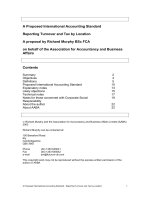How markets really work by laurence a connors
Bạn đang xem bản rút gọn của tài liệu. Xem và tải ngay bản đầy đủ của tài liệu tại đây (10.17 MB, 164 trang )
HOW MARKETS
REALLY WORK
Trắc nghiệm kiến thức Forex tại : />
HOW MARKETS
REALLY WORK
3 3 3 3 3 3 3 3 3 3 3 3 3 3 3 3 3 3 3 3 3 3 3 3 3 3 3 3 3 3 3
Laurence A. Connors
Conor Sen
Connors Research Group
™
PUBLISHING GROUP
Trắc nghiệm kiến thức Forex tại : />
Copyright © 2004, Connors Research Group
ALL RIGHTS RESERVED. No part of this publication may be reproduced, stored in a
retrieval system, or transmitted, in any form or by any means, electronic, mechanical,
photocopying, recording, or otherwise, without the prior written permission of the
publisher and the author.
This publication is designed to provide accurate and authoritative information in regard to the subject matter covered. It is sold with the understanding that the author
and the publisher are not engaged in rendering legal, accounting, or other professional
service.
Authorization to photocopy items for internal or personal use, or in the internal or
personal use of specific clients, is granted by The Connors Group, Inc., provided that
the U.S. $7.00 per page fee is paid directly to The Connors Group, Inc., 1-213-955-5858.
ISBN 0-9755513-1-0
Printed in the United States of America.
Trắc nghiệm kiến thức Forex tại : />
Disclaimer
It should not be assumed that the methods, techniques, or indicators presented in this
book will be profitable or that they will not result in losses. Past results are not necessarily indicative of future results. Examples in this book are for educational purposes
only. The author, publishing firm, and any affiliates assume no responsibility for your
trading results. This is not a solicitation of any order to buy or sell.
The NFA requires us to state that “HYPOTHETICAL OR SIMULATED PERFORMANCE RESULTS HAVE CERTAIN INHERENT LIMITATIONS. UNLIKE AN ACTUAL PERFORMANCE RECORD, SIMULATED RESULTS DO NOT REPRESENT
ACTUAL TRADING. ALSO, SINCE THE TRADES HAVE NOT ACTUALLY BEEN
EXECUTED, THE RESULTS MAY HAVE UNDER- OR OVERCOMPENSATED FOR
THE IMPACT, IF ANY, OF CERTAIN MARKET FACTORS, SUCH AS LACK OF LIQUIDITY. SIMULATED TRADING PROGRAMS IN GENERAL ARE ALSO SUBJECT
TO THE FACT THAT THEY ARE DESIGNED WITH THE BENEFIT OF HINDSIGHT.
NO REPRESENTATION IS BEING MADE THAT ANY ACCOUNT WILL OR IS
LIKELY TO ACHIEVE PROFITS OR LOSSES SIMILAR TO THOSE SHOWN.”
Trắc nghiệm kiến thức Forex tại : />
To Bill James,
the inspiration behind this book.
Trắc nghiệm kiến thức Forex tại : />
CONTENTS
ACKNOWLEDGMENTS
CHAPTER
CHAPTER
CHAPTER
CHAPTER
CHAPTER
CHAPTER
1
2
3
4
5
6
xi
MARKET EDGES
1
SHORT-TERM HIGHS AND SHORT-TERM LOWS
7
HIGHER HIGHS AND LOWER LOWS
21
UP DAYS IN A ROW VS. DOWN DAYS IN A ROW
35
MARKET BREADTH
53
VOLUME
75
ix
Trắc nghiệm kiến thức Forex tại : />
x
CHAPTER
CHAPTER
CHAPTER
CHAPTER
CHAPTER
7
8
9
10
11
LARGE MOVES
83
NEW 52-WEEK HIGHS, NEW 52-WEEK LOWS
95
PUT/CALL RATIO
107
VOLATILITY INDEX (VIX)
119
USING THE INFORMATION IN THIS BOOK
137
ABOUT THE AUTHORS
143
Trắc nghiệm kiến thức Forex tại : />
ACKNOWLEDGMENTS
3 3 3 3 3 3 3 3 3 3 3 3 3 3 3 3 3 3 3 3 3 3 3 3 3 3
Special thanks to Ed Allen, Eddie Kwong, Brice Wightman, Judy Brown
and Michael Chalapong for their assistance in helping us with this book.
xi
Trắc nghiệm kiến thức Forex tại : />
CHAPTER
1
MARKET EDGES
3 3 3 3 3 3 3 3 3 3 3 3 3 3 3 3 3 3 3 3 3 3 3 3 3 3
For many of us, Michael Lewis’ 1989 best-selling book Liar’s Poker was the
first inside look at what day-to-day life was like at a major Wall Street trading firm. Lewis described in detail, the wheeling and dealing of some of the
famous (and infamous) Wall Street titans who oversaw billions of dollars of
transactions every trading day during the 1980s. The book remains a classic
today but 14 years after it was published, Lewis outdid himself. In 2003, he
published Moneyball: The Art of Winning an Unfair Game. The book chronicles
the success of the Oakland A’s, who under the guidance of their General
Manager, Billy Beane, used massive amounts of statistical data to help them
successfully run their ball team.
The A’s essentially turned their backs on the old school of thinking,
much of which was intuitive, and attempted to turn baseball into a science. Players who should have been 15th-round draft picks were being
chosen by the A’s near the top of the draft (and signed very cheaply).
These types of players were chosen not because they “looked good” or
the scouting reports said they “couldn’t miss.” They were chosen because
the statistics said that these players had an edge and that this edge had a
better chance of playing itself out than the “guessing” that had gone into
past selections. Essentially, Billy Beane and the A’s turned baseball upside down and by relying upon numbers instead of opinion, they have
been able to successfully compete against teams that had far more money
to spend on talent.
1
Trắc nghiệm kiến thức Forex tại : />
2
Chapter 1
The godfather behind this move to relying upon numbers instead of gut
is a brilliant gentleman by the name of Bill James. In the 1970s James began publishing studies and then books on player evaluation and baseball
strategy. Up until a few years ago, James was all but ignored by mainstream baseball. Hall of Fame Manager Sparky Anderson, who is the
only manager to win a World Series in both the National League and the
American League, referred to James as “a fat guy with a beard who
knows nothing about nothing.” And in spite of the success that the A’s
and a few other teams have had relying upon statistics, the debate still
rages as to its effectiveness. But, as this is being written, baseball has begun the process of turning away from the Sparky Anderson school of
knowledge and accepting the thinking of people like Bill James. General
Managers are being hired by teams not for their baseball playing careers
nor their baseball prowess, but for their ability to analyze baseball statistics and make correct decisions using these statistics. Teams like the Red
Sox and the Dodgers now have GMs who are only in their early thirties.
Why are they entrusted with franchises that are valued in the hundreds
of millions of dollars? It’s because these guys don’t guess. They know
numbers and their understanding of these numbers provides them with an edge.
And in some cases, this edge is substantial.
What does this have to do with trading? A lot. After we read Moneyball,
we remarked that it’s amazing that baseball has gone this route yet
most of Wall Street still has not. If baseball has quantified mainstream
parts of the game such as batting average, on base percentage, errors,
steals, walks, etc., why hasn’t Wall Street done the same with the indicators it relies upon every day? Trading day after trading day, we are
bombarded with information from the media. “The market rose for the
third straight day as the bulls are taking charge.” What does this mean?
It sounds good, doesn’t it? It sure feels like the market is going to continue to rise. A market rising three days in a row is usually rising because of good news. Isn’t that a precursor of things to come? What
about advancing issues and declining issues? On days the market drops
sharply and declining stocks far outnumber advancing stocks, the press
and the analysts tell us this is bad. Poor market breadth is supposedly a
sign of future weakness. It seems to make sense. But is it true? (You’ll
soon see it’s not.)
Just as old school baseball used to think that a guy who was 6’3" and
could run fast and hit the ball a mile was a “can’t-miss prospect,” much
of old school Wall Street still thinks that good news and market strength
is a sign of future upward price movement and bad news and poor mar-
Trắc nghiệm kiến thức Forex tại : />
Market Edges
ket strength is a sign of future downward movement. As you will soon
learn, at least looking at the market over the past 15 years (1989–2003),
there is nothing further from the truth. This is not our opinion or guess.
It’s what the statistics show. And just as baseball had a tough time accepting the fact that on base percentage is more important than batting average, we suspect that many people on Wall Street, especially the media
and the mainstream firms, will have a tough time accepting the fact that
it’s better over the near term for the market to have dropped than for it
to have risen.
All combined, we have nearly three decades of trading and research experience behind us. Much of what you will learn from this book is a culmination of our work. We looked at a number of the most common ways
traders, analysts and the press look at the market. Even though we went
into the tests having a strong clue where the results would end up, even
we were surprised at some of these results. The tests included us looking
at how the S&P 500 cash market (SPX) and the Nasdaq 100 cash market
(NDX) did over a 1-day, 2-day and 1-week period after they made a 5-period high, 10-period high, 5-period low and 10-period low (intraday). We
also looked at how these markets did after prices rose multiple days in a
row (showing strength) and declined multiple days in a row (showing
weakness). We looked at the times when the markets made multiple-day
higher highs and multiple-day lower lows, again looking at what happened after continuous strength and weakness. From there we looked at
the days when the market rose sharply to the upside versus declined
sharply to the downside.
Volume was another topic we tackled as it is one of the most often-used
indicators. After volume, you’ll learn about market breadth when we analyze what the market has done after advancing issues outperformed declining issues (and vice versa). The results from many of these chapters
may surprise you and this chapter may be the biggest surprise.
From there, we looked at another common indicator: new 52-week highs
and new 52-week lows. There’s a healthy edge here and again, it’s not
where the analysts and the press say it is. In the final two chapters we’ll
show you how to use the put/call ratio and the VIX (CBOE Volatility Index). Each indicator has shown strong consistent edges and we’ll teach
you where these edges are.
Before we move to the next chapter and start looking at the test results,
we’d like to cover a few guidelines to help you better understand how to
Trắc nghiệm kiến thức Forex tại : />
3
4
Chapter 1
use this book and how to use the information presented to help gain a
greater edge in your trading and investing.
1. We’ll state this again later in the book, but you need to know that there
are no assurances that these test results will hold up in the future. Even
though many of these tests are independent of one another and basically lead to the same conclusion, it cannot be assumed this conclusion
(or any market conclusion) will hold true in the future.
2. Much of Wall Street is made up of opinions. It’s also made up of opinions that are not backed by any statistical evidence. If the baseball
world can do it then Wall Street can do it too. Hopefully this book is
just the tip of the iceberg in using statistics to help understand how
markets behave and how one can make proper and rational decisions
on a day-to-day basis.
3. All these tests were run on the cash market and were not actual trades.
Also, commissions and slippage were not factored in.
4. All the tests use a benchmark. This means we compared apples to apples. We looked at the results when certain situations occurred versus
how the market performed on average during the same time period.
We did the same for the percentage of trades that showed gains. In
many cases we could have shown more test results but we didn’t because the number of opportunities they occurred (the sample size) was
too low.
5. We tested the S&P 500 and the Nasdaq 100 cash markets throughout
the book.
6. Many of the tests run as far back as 15 years. This encompassed a solid
bull market, followed by a very severe bear market, followed by a rally
in 2003. The net bias was up for the entire time frame but the market
also saw some healthy selling periods, especially from 2000–2002.
7. Finding clean market data is not as easy as one would think. There are
data vendors whose data we could not trust. Therefore we used data
from sources we trusted including the CBOE’s for the put/call ratio
tests and the VIX tests. In many cases we tested up to 15 years of data
but in some cases we had to use fewer years in order not to compromise the integrity of the test results. These tests were run multiple
times in order to assure the results. If you elect to do your own testing
and find different results, it might possibly be due to the data your
data vendor is providing.
Trắc nghiệm kiến thức Forex tại : />
Market Edges
8. In many chapters we also looked at the market trend. We defined the
market trend as being up when the market was above its 200-day
moving average (200-day ma) and down when it was below its
200-day moving average.
9. None of these tests are systems, nor should they be traded as systems,
nor do we trade them alone as systems. They simply look at how markets behaved over a fixed period of time in specific market conditions.
10. This book can be used by everyone and should provide you with a basic philosophy for looking at the markets. Traders especially will be
able to use this information as the focus of the book is on the
short-term. But interestingly enough, you will see the same type of statistical evidence in long term investing using the basic philosophy and
concepts from this book at www.AlwaysBuyValue.com (the site is related to us).
11. Please understand that the results you will see are average returns.
This means that there were gains and losses in any individual trade
that were far from average. And going forward, there will undoubtedly be situations that occur that will be far from the averages published here.
12. You’ll see one common theme throughout this book: buying short-term
weakness has outperformed buying short-term strength over the past
15 years. Should this trend continue, there is a big edge here for traders
to take advantage of. The goal of this work is to show you when these
times occurred and what the historical edge has been.
Let’s now move ahead and look at specific market conditions.
Trắc nghiệm kiến thức Forex tại : />
5
Trắc nghiệm kiến thức Forex tại : />
Special Offer
Special Offer
Free 7‐day Trial of Larry Connors’
Daily Trading Service
TradingMarkets Daily Battle Plan for Stocks
If you enjoyed this chapter and would like to receive
set‐ups each day based upon the concepts in How
Markets Really Work, try a free trial to the
TradingMarkets Daily Battle Plan for Stocks
published by Larry Connors.
For your free trial click below or go to:
/>
or
Call toll free 1‐888‐484‐8220, ext 1
(Outside the U.S. call 213‐955‐5858 ext. 1)
Special Offer
Trắc nghiệm kiến thức Forex tại : />
CHAPTER
2
SHORT-TERM HIGHS
AND SHORT-TERM LOWS
3 3 3 3 3 3 3 3 3 3 3 3 3 3 3 3 3 3 3 3 3 3 3 3 3 3
Many
traders and investors have been taught to buy strength and sell
weakness. Buying new short-term highs is supposed to be the sign of a
healthy market and selling new short-term lows is supposed to be the sign
of a weak market. Our results over a 15-year period show the exact opposite.
The highlights of the results include the fact that buying new 10-day
highs in the S&P 500 lost money when exiting one week later. In a powerful bull market, you would have actually lost money by buying these
new highs and exiting a week later. Said another way, prices on average
have been lower, not higher, one week after the market has made a
short-term new high.
Let’s now look at a few of our test results.
The Market Has Declined (on Average) Following 5- and
10-Day Highs
1. First we looked at the S&P 500 from January 1, 1989 through December 31, 2003. We then looked at how the SPX performed every day
during that period of time. We found that the SPX had gained an aver-
7
Trắc nghiệm kiến thức Forex tại : />
8
Chapter 2
age of .04% per day and an average of .19% per week for the 15-year
period, reflecting the bull market move.
We then looked at the average daily gain of the SPX after it made a
new 5-day (intraday) high. Remember, new highs are supposedly a
sign of strength, are “breakouts,” and are considered by many a time
to buy. What we found was the opposite. These new highs underperformed the average daily market. Their average daily gain for the next
day was half, coming in at .02%. We also looked at how these “breakouts” did over the next week and again we see them performing
poorly. In fact, the average 1-week gain was .03%, far less than the
average weekly gain of .19% over the same time period.
Ten-day new highs, which are considered even stronger markets to be
buying, showed even worse results. Their average daily gain after the
SPX made a new 10-day high was .00%. The weekly results were just
as poor, also showing no gain.
Returns Increased Following 5- and 10-Day Losses
2. We then looked at when markets were acting poorly. We looked at the
performance of the SPX after it made a new 5-day low. Again, our
findings were completely at odds with conventional teachings. We
found that the average daily gain after a 5-day low was .06%. The average weekly gain was .47%, outperforming the average week and far
outperforming the week following a new 5-day high. The 10-day new
lows showed similar performance. The average daily gain following a
10-day new low was .12% and .56% for the weekly gain.
New Highs Made Under the 200-Day Moving Average
Strongly Underperformed
3. We also looked at the impact that trend had with a market making a
new short-term high versus a new short-term low. We found that, buying a new 5-day high when the SPX was trading under its 200-day
moving average showed a 1-day return of –.04% and only a small
1-week gain of .01%. Ten-day new highs lost money both the next day
(–.05%) and the next week (–.12%). These results show that “bear
traps“ do exist when markets rally while trading under their 200-day
moving average and you would probably be wise to avoid buying equities during these days.
Trắc nghiệm kiến thức Forex tại : />
Short-Term Highs and Short-Term Lows
Pullbacks Within the Direction of the Trend Are Significant.
Rallies Counter to the Trend Underperformed
4. When you combine both price movement with trend, you see additional significant results. For example, when a 10-day low occurred in
the S&P 500, when it was above its 200-day moving average, it led to
higher prices 60.49% of the time the next day. When the index made a
10-day high below the 200-day moving average, prices rose only 46.8%
of the time the next day.
Now let’s look at the bar graphs, time charts, and the entire test results of
how the SPX and the NDX have performed after making 5-day highs,
10-day highs, 5-day lows, and 10-day lows.
Figure 2-1
1989–2003
5-Day Lows in the S&P 500 Significantly Outperformed 5-Day Highs
Trắc nghiệm kiến thức Forex tại : />
9
10
Chapter 2
Figure 2-2
1989–2003
10-Day Lows in the S&P 500 Greatly Outperformed 10-Day Highs
Trắc nghiệm kiến thức Forex tại : />
Short-Term Highs and Short-Term Lows
Figure 2-3
1989–2003
New 5-Day Highs in the Nasdaq Underperformed versus 5-Day Lows
Trắc nghiệm kiến thức Forex tại : />
11
12
Chapter 2
Figure 2-4
1989–2003
Nasdaq 100 10-Day Lows Outperformed 10-Day Highs by a Better
Than 3-1 Margin
Trắc nghiệm kiến thức Forex tại : />
Short-Term Highs and Short-Term Lows
Figure 2-5
Time Graph Performance Comparison
All time graphs in this book use a one-week exit.
Trắc nghiệm kiến thức Forex tại : />
13
14
Chapter 2
Figure 2-6
Trắc nghiệm kiến thức Forex tại : />
Short-Term Highs and Short-Term Lows
Figure 2-7
Trắc nghiệm kiến thức Forex tại : />
15
16
Chapter 2
Figure 2-8
Trắc nghiệm kiến thức Forex tại : />









